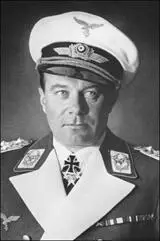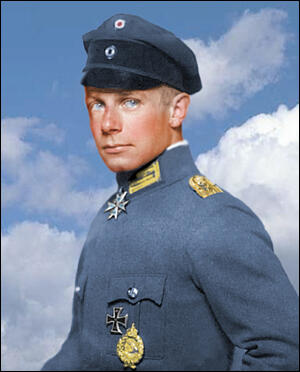Ernst Udet

Ernst Udet was born in Frankfurt, Germany, on 26th April 1896. He joined the German Army Air Service in 1915. Flying a Fokker D-III , he scored his first victory on 18th March 1916 in a lone attack on 22 French aircraft. By the end of the First World War Udet had 62 victories. This made him the second highest German war ace of the war.
After the war Udet appeared with Leni Riefenstahl in the film SOS Eisberg. He was also active in the Richthofen Veterans' Association and caused great controversy when he campaigned to have Hermann Goering rejected for for making false claims of air victories during the First World War.
Udet joined the Luftwaffe in June 1935 as a colonel and a year later was appointed head of the Technical Office of the Air Ministry. In this post Udet was responsible for the introduction of the Junkers Stuka and the Messerschmitt Bf109.
During the Second World War he rose to the rank of colonel general and Director of Air Armaments. In 1940 pilots began to complain that the Spitfire was superior to German aircraft. Later Adolf Hitler and Hermann Goering both accused him of being responsible for the defeat of the Luftwaffe during the Battle of Britain. He was also criticized for neglecting the development of new heavy bombers. life.

Udet became depressed by the performance of the Luftwaffe during Operation Barbarossa and the decision by Erhard Miltch to overrule his plans to develop the Focke Wulf FW 190. On 17th November, 1941, Udet shot himself in the head while on the phone to his mistress.
Adolf Hitler was embarrassed by Udet's death and the Nazi Government issued a statement that Udet had been accidentally killed while testing out a new weapon. The award-winning play, The Devil's General by Carl Zuckmayer, was based on Udet's life.
Primary Sources
(1) Ernst Udet, was one of those German pilots who encountered Georges Guynemar in a dogfight.
We met at the same altitude. As the sun caught it, I saw the other man's machine painted light brown. Soon we were circulating round each other playing for an opening. Below we probably looked like two great birds of prey indulging in spring-time frolics, but we knew it was a game of death. The first man to get behind the other's back was the winner. In the single-seater fighters you could only shoot forward, and if your opponent got on your tail you were lost.
Sometimes we passed so near to each other that I could see every detail of my opponent's face - that is, all that was visible of it below his helmet. On the machine's side there was a Stork and two words painted in white. The fifth time that he flew past me I managed to spell out the word, Vieux. And Vieux Charles was Guynemar insignia. Georges Guynemar had some 30 victories to his credit and I knew that I was in for the fight of my life.
I tried every trick I knew - turns, loops, rolls, sideslips - but he followed each movement with a lightning speed and gradually I began to realize that he was more than a match for me. But I had to fight on, or turn away. To turn away would be fatal.
For eight minutes we had been flying round each other in circles. Suddenly Guynemer looped, and flew on his back over my head. That moment I relinquished hold of the stick, and hammered with both hands at the machine-gun. I missed him and he again passed close over my head, flying almost on his back. Guynemer now knew I was his helpless victim. And then, to my great surprise, he raised his arm and waved to me. Guynemer gave proof that even in modern warfare there is something left of the knightly chivalry of bygone days.
(2) Albert Speer, Inside the Third Reich (1970)
Goering was not actually blind to reality. I would occasionally hear him make perceptive comments on the situation. Rather, he acted like a bankrupt who up to the last moment wants to deceive himself along with his creditors. Capricious treatment and blatant refusal to accept reality had already driven the first chief of Air Force Procurement, the famous fighter pilot Ernst Udet, to his death in 1941.

